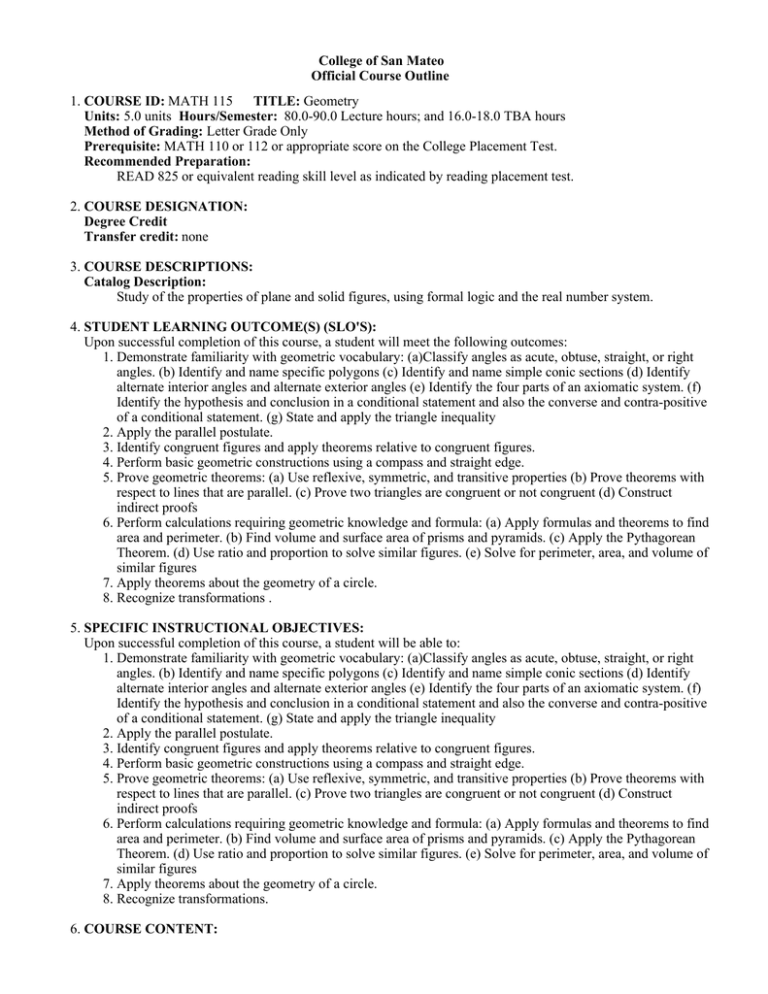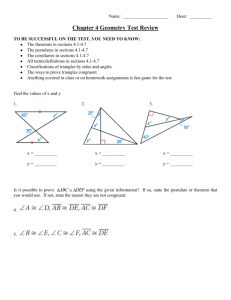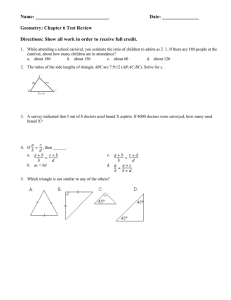College of San Mateo Official Course Outline COURSE ID: Units:
advertisement

College of San Mateo Official Course Outline 1. COURSE ID: MATH 115 TITLE: Geometry Units: 5.0 units Hours/Semester: 80.0-90.0 Lecture hours; and 16.0-18.0 TBA hours Method of Grading: Letter Grade Only Prerequisite: MATH 110 or 112 or appropriate score on the College Placement Test. Recommended Preparation: READ 825 or equivalent reading skill level as indicated by reading placement test. 2. COURSE DESIGNATION: Degree Credit Transfer credit: none 3. COURSE DESCRIPTIONS: Catalog Description: Study of the properties of plane and solid figures, using formal logic and the real number system. 4. STUDENT LEARNING OUTCOME(S) (SLO'S): Upon successful completion of this course, a student will meet the following outcomes: 1. Demonstrate familiarity with geometric vocabulary: (a)Classify angles as acute, obtuse, straight, or right angles. (b) Identify and name specific polygons (c) Identify and name simple conic sections (d) Identify alternate interior angles and alternate exterior angles (e) Identify the four parts of an axiomatic system. (f) Identify the hypothesis and conclusion in a conditional statement and also the converse and contra-positive of a conditional statement. (g) State and apply the triangle inequality 2. Apply the parallel postulate. 3. Identify congruent figures and apply theorems relative to congruent figures. 4. Perform basic geometric constructions using a compass and straight edge. 5. Prove geometric theorems: (a) Use reflexive, symmetric, and transitive properties (b) Prove theorems with respect to lines that are parallel. (c) Prove two triangles are congruent or not congruent (d) Construct indirect proofs 6. Perform calculations requiring geometric knowledge and formula: (a) Apply formulas and theorems to find area and perimeter. (b) Find volume and surface area of prisms and pyramids. (c) Apply the Pythagorean Theorem. (d) Use ratio and proportion to solve similar figures. (e) Solve for perimeter, area, and volume of similar figures 7. Apply theorems about the geometry of a circle. 8. Recognize transformations . 5. SPECIFIC INSTRUCTIONAL OBJECTIVES: Upon successful completion of this course, a student will be able to: 1. Demonstrate familiarity with geometric vocabulary: (a)Classify angles as acute, obtuse, straight, or right angles. (b) Identify and name specific polygons (c) Identify and name simple conic sections (d) Identify alternate interior angles and alternate exterior angles (e) Identify the four parts of an axiomatic system. (f) Identify the hypothesis and conclusion in a conditional statement and also the converse and contra-positive of a conditional statement. (g) State and apply the triangle inequality 2. Apply the parallel postulate. 3. Identify congruent figures and apply theorems relative to congruent figures. 4. Perform basic geometric constructions using a compass and straight edge. 5. Prove geometric theorems: (a) Use reflexive, symmetric, and transitive properties (b) Prove theorems with respect to lines that are parallel. (c) Prove two triangles are congruent or not congruent (d) Construct indirect proofs 6. Perform calculations requiring geometric knowledge and formula: (a) Apply formulas and theorems to find area and perimeter. (b) Find volume and surface area of prisms and pyramids. (c) Apply the Pythagorean Theorem. (d) Use ratio and proportion to solve similar figures. (e) Solve for perimeter, area, and volume of similar figures 7. Apply theorems about the geometry of a circle. 8. Recognize transformations. 6. COURSE CONTENT: Lecture Content: Lecture Content: 1. Points, Lines A. Distance between two points B. Distance from point to a line C. Perpendicular lines D. Intersecting lines – vertical angles 2. Parallel lines and polygons A. Sum of angles of a triangle B. Parallel postulate C. Types of angles D. Sum of angles of a polygon E. Regular polygons F. Parallelograms 3. Congruent figures A. Corresponding parts of congruent figures/ triangles B. Conditions for congruent triangles C. Congruent right triangles D. Perpendicular bisector of a line E. Isosceles triangles F. Proofs 4. Additional proofs involving A. Parallelograms B. Midpoints of sides of triangles C. Properties of quadrilaterals D. Special right triangles 5. Constructions A. Perpendicular bisector of a line segment B. Perpendicular through a point on a line C. Perpendicular from a point to a line D. Angle bisectors E. Parallel to a given line through a point off the line F. Regular polygons G. Dividing a line segment into equal segments H. Circumscribed circles of a triangle I. Altitudes of a triangle J. Medians of a triangle 6. Area, Volume, Surface Area A. Areas of polygons, including triangles B. Volume of prism C. Surface Area of Prism D. Volume of pyramid 7. Pythagorean Theorem A. Geometric and algebraic proofs B. 30-60-90 and 45-45-90 triangles C. Area of equilateral triangle D. Longest diagonal of a box 8. Similar Figures A. Review of ratio and proportion B. Similar polygons and triangles C. Conditions for similar triangles D. Lines dividing sides of triangle proportionally E. Ratio of similarity F. Perimeter, Area and volume of Similar Figures 9. Circles A. Inscribed angles B. Central angles C. Chords of a circle D. Tangent lines to a circle E. Angle bisectors and the inscribed circle of a triangle F. Circumference and Area of a circle and Area of a sector G. Volume and surface area of the sphere and cylinder H. Volume and Surface area of a cylinder 10. Transformations in the plane: translations, rotations and reflections TBA Hours Content: TBA assignments may be remedial, reinforcement, or extension of ideas presented in class. The assignments may be individualized or designed for all members of the class. Examples of TBA assignments include but are not limited to projects, appointments discussing and getting feedback on written assignments, facilitated group discussions, workshops, assignments designed to provide additional practice for targeted student learning outcomes, assignments that are an extension of other assigned work or investigations of questions/ideas arising in other assigned work. TBA work will be completed with supervision of mathematics faculty, evaluated by the course instructor and are most often completed in the Math Resource Center. . 7. REPRESENTATIVE METHODS OF INSTRUCTION: Typical methods of instruction may include: A. Lecture B. Activity C. Discussion D. Observation and Demonstration E. Other (Specify): Out-of-class assignments: Students will need to complete assigned problems and projects. Reading assignments: Instructor will assign text readings for discussion of a topic in class. Writing assignments: Students will submit written homework assignments, students may be assigned papers including mathematical modeling. Critical thinking: Lecture/discussion to understand problem-solving process, students will practice critical thinking in small group problem solving, students will evaluate proposed solutions in light of constraints of the problem. Resources available on CD and the Internet may be used to supplement the text. Hours by arrangement are completed by working on assignments in the Math Resource Center under the supervision of mathematics instructors working there. 8. REPRESENTATIVE ASSIGNMENTS Representative assignments in this course may include, but are not limited to the following: Writing Assignments: Students will submit written homework assignments. Students may be assigned papers including mathematical modeling. Reading Assignments: Instructor will assign text readings for discussion of a topic in class. Other Outside Assignments: Students will need to complete assigned problems and projects. To be Arranged Assignments: TBA assignments may be remedial, reinforcement, or extension of ideas presented in class. The assignments may be individualized or designed for all members of the class. Examples of TBA assignments include but are not limited to projects, appointments discussing and getting feedback on written assignments, facilitated group discussions, workshops, assignments designed to provide additional practice for targeted student learning outcomes, assignments that are an extension of other assigned work or investigations of questions/ideas arising in other assigned work. TBA work will be completed with supervision of mathematics faculty, evaluated by the course instructor and are most often completed in the Math Resource Center. 9. REPRESENTATIVE METHODS OF EVALUATION Representative methods of evaluation may include: A. Class Participation B. Exams/Tests C. Group Projects D. Quizzes E. Written examination F. Written individual assignments and/or journal- to demonstrate individual student progress toward objectives. Small group presentations- to demonstrate student participation in problem solving process. Written exams/quizzes- to reflect student knowledge of vocabulary, concepts, and application of concepts to problem solving as presented in lectures and discussion, small group sessions, and text readings. Final Examination- to reflect student knowledge of vocabulary, concepts, and applications of concepts to problem solving as presented in lectures and discussions, small group sessions, and text readings. Participation- to reflect student involvement in class discussions, small group sessions and presentations, etc. 10. REPRESENTATIVE TEXT(S): Possible textbooks include: A. Jacobs, H.. Geometry, 3rd ed. New York: Bedford, Freeman and Worth, 2003 B. Musser, Gary and Trimpe, Lynn. College Geometry: A Problem Solving Approach with Applications, 2 ed. Pearson, 2007 Origination Date: March 2015 Curriculum Committee Approval Date: April 2015 Effective Term: Fall 2015 Course Originator: Cheryl Gregory



